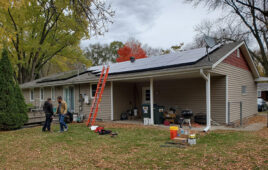The Senate Finance Committee released its draft version of the Build Back Better Act on Dec. 11 and added domestic manufacturing incentives for inverters and trackers. SEIA has been working to get those technologies included in the bill.
The inverter incentives in this version include:
- Central inverters (>1 MW capacity): 2.5¢/W
- Utility inverters (>170 kW, ≤1 MW capacity): 1.5¢/W
- Commercial inverters (≥20 kW, ≤170 kW capacity): 2¢/W
- Residential inverters (≤ 20 kW capacity): 6.5¢/W
- Microinverters (≤ 650 W capacity): 11¢/W
The tracker incentives in this version include:
- Torque tubes: 87¢/kg
- Longitudinal purlins: 87¢/kg
- Structural fasteners: $2.28/kg
Solar panel manufacturing incentives (repeated from the House draft of the BBB Act) in this version include:
- thin-film and silicon PV cells: 4¢/WDC
- wafers: $12/m2
- solar-grade polysilicon: $3/kg
- fully assembled thin-film and silicon modules: 7¢/WDC
This updated version of the bill also includes immediate refundability for the Section 25D residential ITC starting in 2023 instead of after 2024, as previously written. The Residential Renewables for All campaign has been pushing for accelerating that timeline.
“The inclusion of 25D refundability in the Build Back Better Act is a game changer in the fight to promote environmental justice, combat climate change, grow our economy and create high-paying American jobs. The Senate’s version of the bill brings us even closer to this vital moment by accelerating the implementation schedule, which means even more middle- and low-income families will be able to power their homes with clean, affordable energy sources,” the campaign said in a statement.
Senate Finance Committee Chair Ron Wyden (D-OR) said conversations are continuing and the committee is prepared for bipartisan meetings with the Senate parliamentarian this week.
Updated at 11:09 a.m. ET to include refundability provision





So with the “refundable” credit, does that mean that comes back as a check to the user? If someone only owed $5,000 in taxes for the year but their solar credit was $7000, would they get their $5,000 back or would they get $7,000? Just curious how they are planning for it to work.